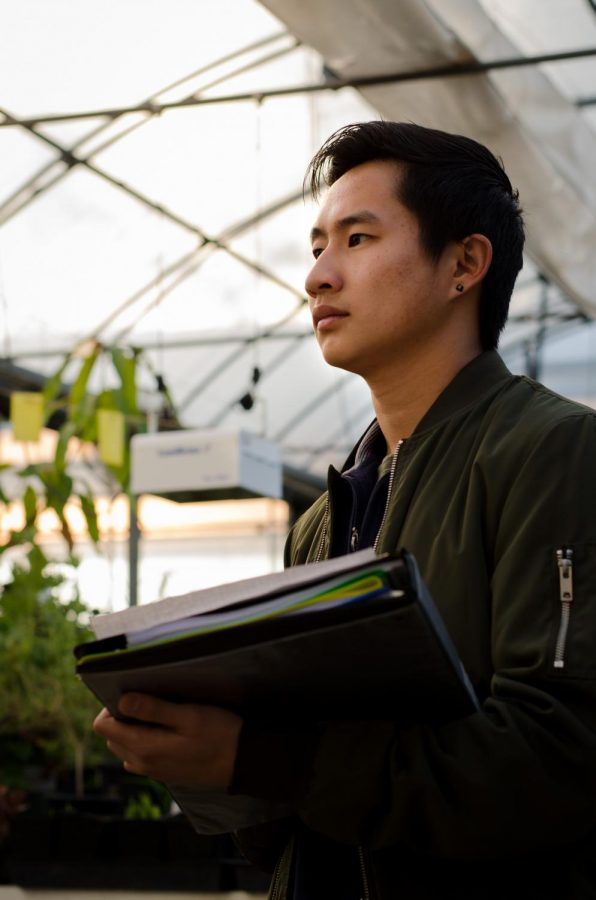Vertical farm a towering feat for DVC community
Brandon Chan, engineering student, 22, creates a to do list for the Vertical Farming Club in a greenhouse at the DVC Horticulture area on Thursday, Feb. 23rd. He, and the rest of the club, are creating a sustainable vertical farming system to grow vegetables in layered beds.
March 12, 2018
Keren Pasule sets about inspecting a series of capped PVC tubes, each with a tidy row of holes drilled into it, stacked on a utility shelf in the balmy greenhouse in the DVC Horticulture Area.
She makes her way over to an empty fish tank, explaining that it will eventually be stocked with roach fish, providing a nutrient rich water source for growing a variety of lettuces.
Pasule, 19, a biochemistry major, is the project manager for DVC’s Vertical Farming Club, which is in the process of constructing an aquaponic vertical farming system.
Unlike traditional methods of farming, which require large swaths of land and soil, a plentiful water supply, and a favorable climate, vertical farming takes place indoors, in grow beds stacked vertically. Crops are grown without soil, with necessary nutrients being delivered through an irrigation system of recirculating water, while LED lights provide a replacement for sunlight.
“Vertical farming is the future of farming,” wrote Peter Swenson, chair of the club, noting that the system offers solutions for many of the issues facing food security and current farming practices.
The Food and Agriculture Organization of the United Nations estimates that there needs to be 50 percent more food for an additional 2.3 billion people by 2050, with two-thirds of that global population living in densely packed urban environments. As already declining rural populations age, the traditional agricultural workforce will dwindle further, creating a significant deficit.
The FAO also point out that roughly 1.3 billion tons of global food production is lost or wasted annually due to natural disasters, spoilage, and long transportation routes.
Through technology and simply by nature of being indoors, they are able to avoid some of the environmental consequences and hardships beleaguering traditional farms with increasing frequency, such as droughts, infestations and hurricanes.
In vertical farms, conditions can be specifically regulated to replicate an optimal growing climate. Water is recycled, requiring significantly less of it. There is no fertilizer runoff into the water supply of natural habitats and little to no need for pesticides.
Such operations can be woven into the urban fabric, often springing up in warehouses, repurposed shipping containers and even skyscrapers. The food is available fresh to the surrounding community, eliminating long haul shipping routes, along with their associated CO2 emissions.
And most importantly said Ryan Moschiano, 23, a horticulture major and Vertical Farming Club member, “It takes up a lot less space.”
Because crops are stacked vertically, the amount of acreage needed to yield a large amount of agricultural product is significantly reduced.
A study by Stanford University, in partnership with the Institute for Food and Resource Economics at the University of Bonn in Germany, found that a vertical farm in Berlin, built on two-thirds of an acre, standing 37 stories tall, yielded 516 times more produce on average than a traditional farm with as much land.
The farm was able to provide 3, 573 tons of edible fruit and vegetables for neighboring residents and restaurants.
According to the study, one hurtle that seems to stand in the way of vertical farms taking off on a large scale is cost. Some factors like the hydroponic nutrients they use as a substitute for soil, are more expensive than in traditional farming.
But the DVC vertical farming students have created a work around for this problem.
It may sound less than savory, but the roach fish will create waste which possesses the nutrients that the plants need to flourish. By filtering the water through the fish tank they can eliminate the need for artificial nutrients thus creating a more feasible, cost-effective system.
Swenson points out that finding these kinds of solutions requires a cross-disciplinary team. Vertical farming offers students the opportunity to learn about and apply skills in horticulture, engineering and project management among many others.
Brandon Chan, 22, an engineering major and club member said, “I like the idea of being able to design a sustainable system and then build it from the ground up.”
The Vertical Farming Club hopes to build a system that sustains itself for years to come and eventually partner with the culinary program on campus to deliver their fresh, high quality produce through the cafeteria.
“We want this to be a community asset, something that really benefits DVC in the long run,” said Pasule.
To learn more about the club visit https://chem.libretexts.org/LibreTexts/Diablo_Valley_College/Vertical_Farming_Project












































































